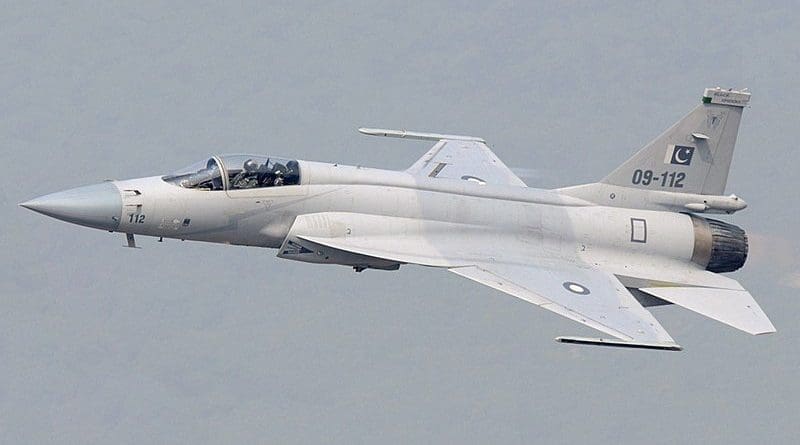Why China Wants To Power Argentina’s Air Force Modernization – Analysis
By Loro Horta*
In early May, several media outlets reported that a Chinese delegation visited Argentina to discuss a major arms deal. The agreement could be a game changer for Argentina and South America’s arms market.
According to reports, the two governments discussed the possibility of selling Argentina Sino–Pakistan JF-17 fighter jets. If the deal goes ahead, this will be the most advanced fighter jet offered by China to the region and could pave the way for future arms deals with other South American countries.
This is not the first time that a major arms deal between China and Argentina has been announced. In 2015, the two countries signed a deal for Argentina’s purchase of several weapons systems. Estimated at US$1 billion, the deal included warships, armoured vehicles and fighter jets. That same year, Argentina’s Defence Minister Agustin Rossi announced that the JF-17 was among the items to be purchased from China.
These agreements were signed during the presidency of Cristina Fernandez de Kirchner (2008–2015), the left-wing and Peronist leader who built close ties with China. The election of right-leaning president Mauricio Macri in December 2015 led to the cancellation of these projects. But since 2019, with the return of a Peronist government and with Kirchner as Vice President, these arms deals are being resuscitated.
Argentina’s financial crises and lack of currency with which to acquire expensive weapon systems have long been an obstacle for China selling defence equipment to Argentina. Yet several factors have emerged that increase the likelihood of success for Chinese weapons companies.
The Argentine Air Force has reached a critical point in its fighter jet inventory. For decades, the French-built Dassault Mirage III interceptor aircraft was the backbone of the Argentinian fighter jet force. In 2015, due to aging aircraft and budget constraints, the Argentine Air Force was forced to retire its fighter jets.
For six years now, Argentina has not possessed fighter interceptors, despite neighbouring countries Brazil and Chile owning modern fighter jets. Argentina has tried to buy new jets from several Western nations, but the UK government has kept an effective arms embargo on the country since the 1982 Falklands War.
The United Kingdom is particularly sensitive to acquisitions of fighter jets, remembering that most UK casualties in the Falklands War were inflicted by the Argentine Air Force. In 2015, Argentina tried to acquire Swedish JAS 39 Gripen fighter jets, but Sweden backed down from the sale due to pressure from London. South Korea also withdrew its offer to sell Argentina fighter jets due to pressure from the United Kingdom. Even the fact that the ejector seat on the JF-17 is built by a UK company has been a point of contention.
Not only are Western arms markets highly restricted in Buenos Aires, but Argentina remains on the verge of bankruptcy. Chinese fighter jets are cheaper than Western ones. China also provides flexible modes of payment and periods of good will, where recipients are not required to pay for several years or can pay in instalments. With Venezuela, US sources claim that China sold weapons on generous terms in exchange for oil at low prices.
The fact that China is willing to jointly produce the JF-17 and share its technology with Argentina further sweetens the deal. Argentina has long preferred agreements that allow for technology transfers in an effort to strengthen its defence industry. Both nations are also negotiating licensing for Argentina to produce Chinese helicopters and armoured vehicles.
While some Argentinian politicians and some sectors in the military have objected to close military cooperation with China, they have not come up with any alternatives. All branches of the Argentinian military, not just the air force, are in urgent need of modernisation.
If the deal goes ahead, the JF-17 project could lay the ground for China’s emergence as a major weapons supplier in a region once dominated by the United States. Yet Beijing’s strategy of financial flexibility with Argentina goes beyond weapons.
Argentina is the second-largest country in Latin America and a member of the G20. The country’s large and sparsely populated territory is rich in natural resources. In March, Argentinian media, citing sources in the President’s office, reported that China and Argentina were negotiating 15 infrastructure projects worth US$30 billion. Chinese companies have invested an estimated US$15 billion in the country’s oil sector. Argentina is also a major source of agricultural exports (including soybeans) to China.
Short-term profits from weapons sales are not Beijing’s main priority. Longer-term political and economic gains are the main drivers of Beijing’s strategy in Argentina. Despite its many problems, Argentina is a significant regional country. Beijing recognises this and is committed to consolidate its presence in Argentina at a time when the country desperately needs help.
*About the author: Loro Horta is a public servant based in Dili and is a former Timor-Leste ambassador to Cuba. All views expressed in this article are strictly the author’s own.
Source: This article was published by East Asia Forum

